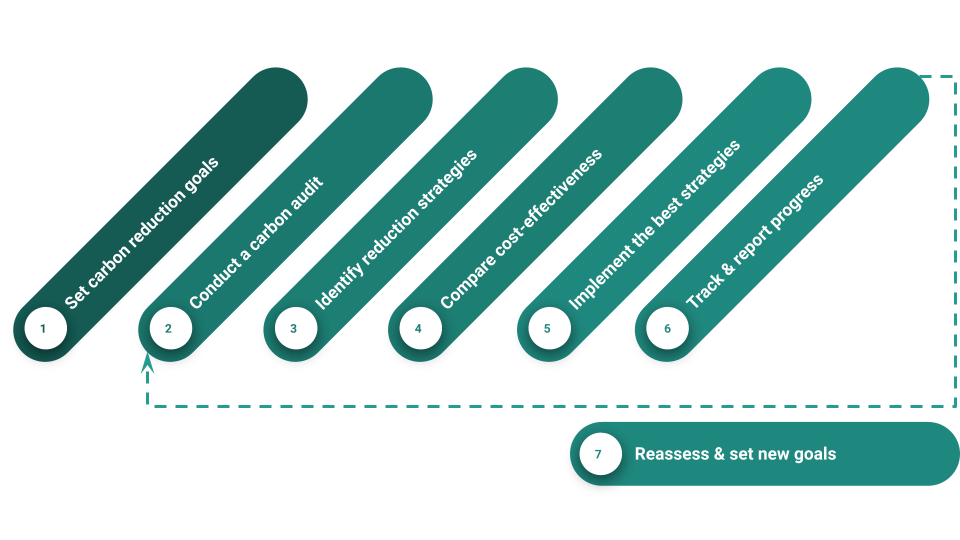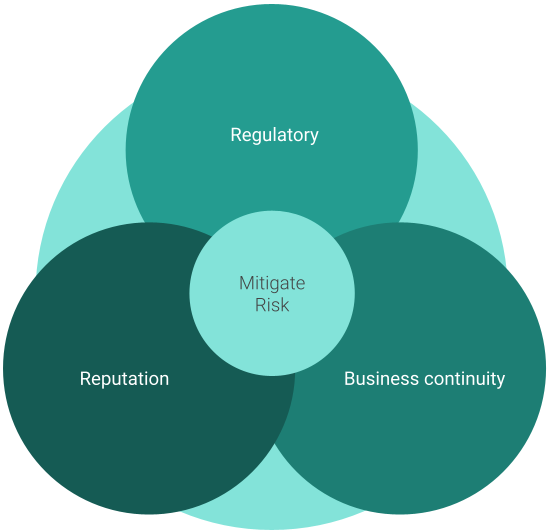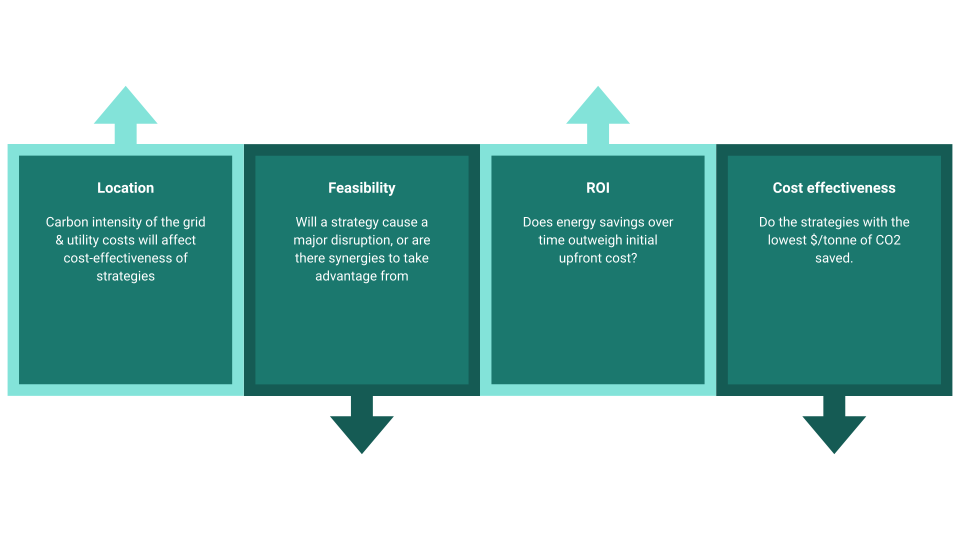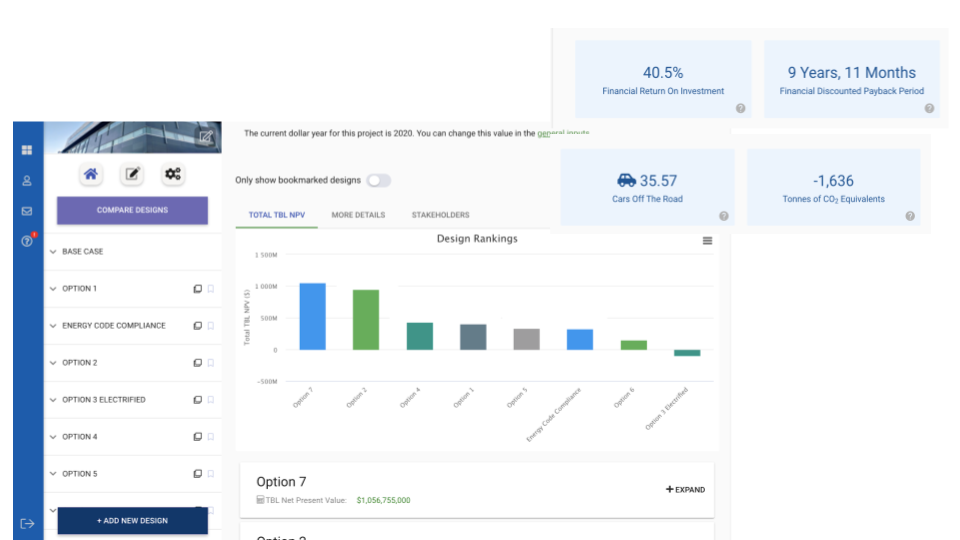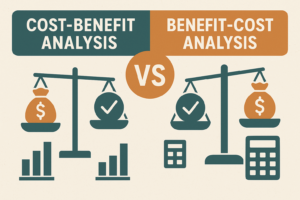A 7-step guide for building portfolio owners on how to reduce carbon emissions in the most cost-effective way.
Click here to download the full report.
So you’ve set firm-wide carbon reduction goals? Great! But you or your company may be saying…’Now what?’.
The important thing is not just about setting carbon reduction goals – it’s about what to do after you set your carbon goals. The key question is, ‘How do you reduce carbon in the most cost effective way across your portfolio?’
This blog will outline the key steps for building portfolio owners like universities, airports, developers, and tech companies to reduce carbon in the most cost-effective way.
The business case to act now
The most recent IPCC report results paint a dire warning about the global implications of climate change if we don’t rapidly reduce CO2 emissions.
Buildings contribute roughly 40% of global CO2 emissions, with building energy use making up 28% of overall global emissions. So as building owners, it’s vital that 1) you build new buildings that are energy efficient and with low embodied carbon in materials, and 2) perform deep retrofits in your existing stock of buildings to reduce their energy use intensity.
There is a business case to act now from a risk-mitigation perspective:
Regulatory risk
- Around 50 cities have banned natural gas in new buildings. This may expand to existing buildings. It may be less costly to be ahead of the curve rather than playing catch up.
Reputational risk
- Investors and consumers want greater transparency on key ESG metrics like carbon, and they will vote with their wallets
- Tenants want to be in sustainable high performance spaces. You don’t want to fall by the wayside and for your buildings to be left vacant or renting out for less money.
Business continuity risk
- We have seen that extreme weather events are having impacts on supply chains as well as on direct operations. Building resilience and redundancy to your portfolio is key to thriving under an uncertain future, as well as mitigating climate change.
Step 1: Set carbon reduction goals
If you’re reading this, you may have already completed this step. Good for you.
You’re joining a swathe of companies that have made commitments that align with science-based targets & the Paris agreement to limit carbon emissions for a 1.5 degree of warming.
If you’re part of a large company and you haven’t set goals, there’s no time to waste to Paris-proof your organization.
But it’s not just down to large companies. Smaller firms can get in on the action as well.
Whatever target you set, this is the first major step.
Step 2: Conduct a carbon audit to know where your CO2 emissions are coming from
You can’t manage what you don’t measure. This old adage is true for reducing your carbon emissions. In order to understand how you can reduce your emissions, you need to first know how much carbon your company emits and – crucially – where those emissions derive.
To do this, you need to conduct a carbon audit – or carbon inventory. Like any other audit, a carbon audit is an investigation into how much carbon you emit and where in your business those emissions are coming from.
Follow existing protocols
You can follow protocols to help standardize your audit, such as:
- USEPA Greenhouse Gas Reporting Program (GHGRP)
- Greenhouse Gas Protocol from World Resources Institute (WRI) & World Business Council for Sustainable Development (WBCSD)
- ISO 14067:2018 Carbon footprint of products — Requirements and guidelines for quantification
Bucket your emissions into scope 1, 2, or 3
There are three buckets – or ‘scopes’ of CO2 emissions:
- Scope 1 emissions covers direct emissions like fuel combustion or on-site vehicles.
- Scope 2 emissions are indirect emissions from the generation of electricity used on site.
- Scope 3 includes all other indirect emissions like business travel & commuting, waste disposal, and embodied carbon in materials etc.
Carbon from building operations & energy use typically falls into Scope 1 & 2.
Group your emissions into each of these buckets to see how much control you have over your CO2 emissions at a high level. Then break the data down as much as possible (by building, sub-meter, etc.) so that you can get granular into the exact source. This will help you in the next step: Identifying strategies to reduce your carbon emissions.
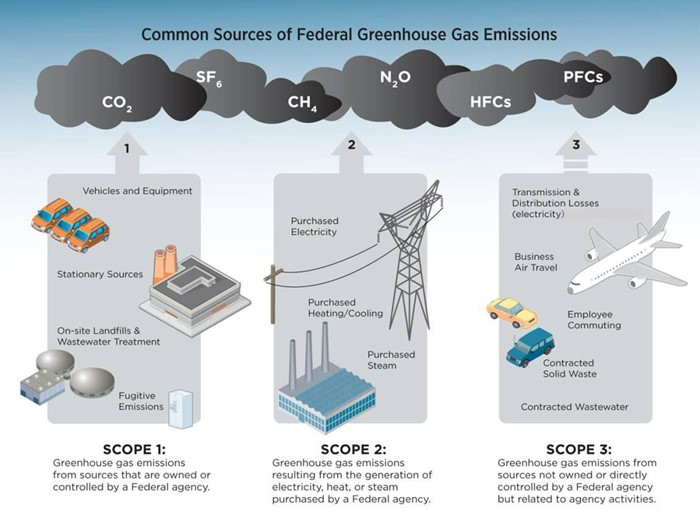
Source: EPA https://www.epa.gov/greeningepa/greenhouse-gases-epa
Step 3: Identify carbon reduction strategies at the building-level and policy-level.
Now that you have a good sense for how much CO2 you emit and where in your operations that CO2 is coming from, you can get to work on identifying ways to reduce it.
There are two key levers that you can pull: at the building-level and policy-level.
Building-level actions
At a building-level, you may be able to pull the levers like:
- Upgrade all lighting to LEDs
- Improve windows (triple pane)
- Improved wall and roof insulation
- Heat pump water heater
- Install on-site renewable energy
- Retro-commissioning
Policy-level actions
There are also campus & firm-wide levers such as:
- Purchase GHG-free electricity
- Update your sustainability design guidelines so that all new projects meet more stringent energy standards.
- Mandate all electric building design strategies
- Require low-embodied carbon and sustainable materials for construction
- Electric central utility plants for campus-wide energy
Create an exhaustive list of potential actions or strategies
The goal at the end of this step is to have a fairly exhaustive list of all the ways in which you could reduce carbon emissions. Some of these ideas may be good, and others may be fruitless.
There’s a sure-fire way to make sure you choose the right strategies that are going to give you the best bang for your buck, which is covered in the next step.
Step 4: Compare the cost-effectiveness of each strategy using the right tools.
Not all strategies make sense
You likely won’t be able to implement all the strategies you identified in the previous step. Some things to consider, include:
Location
It’s really important to remember that if you own buildings across the country – or across the world – each location has its own energy costs and grid emission factors, which affect carbon intensity. So the same strategy in each place will generate a different cost-effectiveness score.
Feasibility
Some strategies may reduce your carbon emissions greatly but are unaffordable or would cause a major change in your company’s operations. However, it’s also worth looking for synergies with other organizational activities. For example, perhaps some of your strategies align with an already-planned deep retrofit of an existing building, and so the upfront costs would have happened anyway.
ROI
It’s likely that most strategies will come with some kind of upfront cost. However many carbon/energy saving strategies will actually reduce utility costs. So there could be some that have a positive ROI and make financial sense.
Cost-effectiveness
Some strategies will reduce a lot of carbon but may come with a hefty price tag. The best thing to do is equalize them all by dividing the cost by the amount of carbon they save. You can then prioritize strategies that are going to be the most cost-effective – i.e. those with the lowest $/tonne of CO2 reduced.
Use the right tools to simplify comparing the cost-effectiveness of carbon reduction strategies
As you can probably tell, comparing the cost-effectiveness of each carbon reduction strategy across various locations is not easy if you don’t have the right tools.
Autocase has developed an online tool that automatically calculates the carbon reduction and utilities saved (in dollars) so you can quickly compare the cost effectiveness of energy efficiency measures side by side.
Screenshot of the Autocase carbon tool
Because Autocase provides both the carbon saved as well as the dollars saved, it makes it easier for you to get the buy-in from leadership to implement the carbon reduction strategies.
Step 5: Implement the best strategies
Once you have estimated the cost-effectiveness of each carbon reduction strategy, you can rank them in order of priority.
The next step is to implement them.
Work with your project managers, buildings and facilities teams, and program managers to put these strategies into action.
Step 6: Track, report, and communicate building performance.
It’s important to track your progress in order to know if you’re meeting the goals you set out to meet.
Tracking tools
There are tools to help you centralize & track your carbon emissions in buildings. Arc is a platform that measures building performance across some key ESG categories like energy & carbon, water, waste, and transportation.
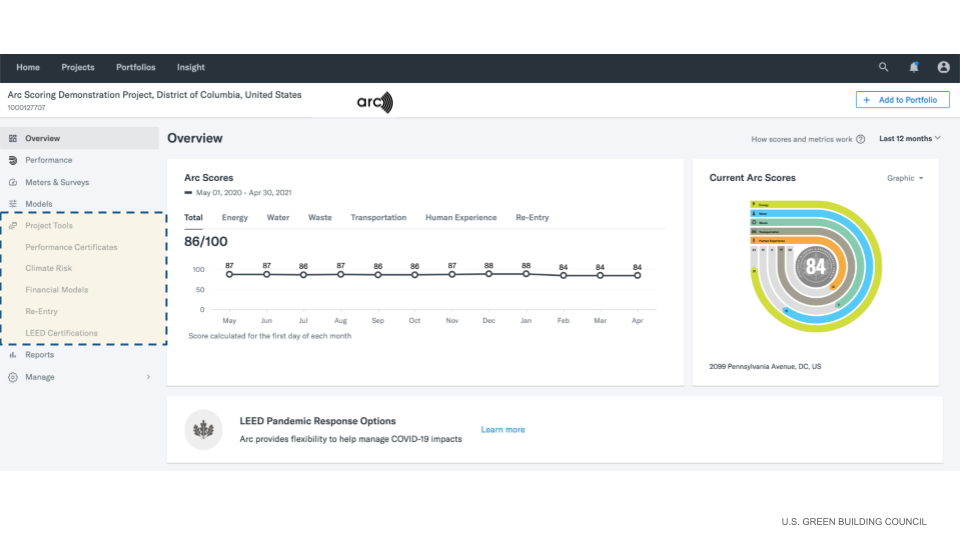
Autocase has integrated with Arc to show the financial impact of some of those ESG performance related to energy, carbon, and water for past performance, as well as future goals.
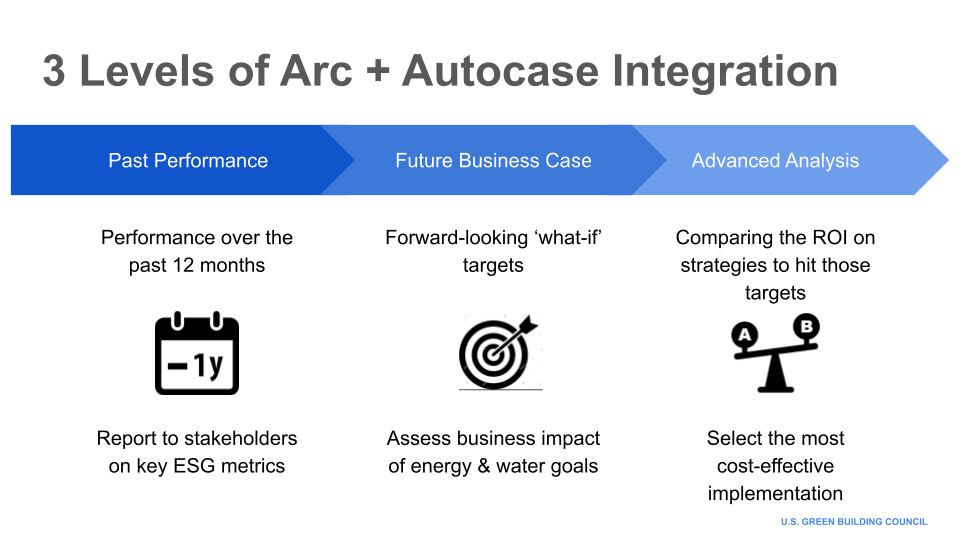
Use these tools to help see how you’re performing against your intended goals over time and across locations.
Report & disclose
As we mentioned earlier, investors and consumers are demanding greater disclosure & transparency into greenhouse gas emissions.
There are various reporting frameworks you can align with, and we’ve provided a quick breakdown of the major ones for you to look at:
- Global Reporting Initiative (GRI): is an international independent standards organization that helps businesses, governments and other organizations understand and communicate their impacts on issues such as climate change, human rights, and corruption.
- Science Based Targets (SBT): shows companies how much and how quickly they need to reduce their greenhouse gas (GHG) emissions to prevent the worst effects of climate change.
- Sustainability Accounting Standards Board (SASB): guides the disclosure of financially material sustainability information by companies to their investors, the Standards identify the subset of environmental, social, and governance (ESG) issues.
- Task Force on Climate-Related Financial Disclosures (TCFD): allows companies to incorporate climate-related risks and opportunities into their risk management and strategic planning processes.
- CDP: is a not-for-profit charity that runs the global disclosure system for investors, companies, cities, states and regions to manage their environmental impacts.
Whichever framework you choose to align with, make sure you have the processes in place to gather the information from all the relevant internal stakeholders.
Communicate
Lastly, it’s important to be accountable to your goals. Do this by communicating your successes (and areas for improvement) both internally and externally. By sharing this across your firm, it will ensure employees support future efforts to decarbonize and create a positive feedback loop.
Step 7: Reassess & set new goals
Now that you’ve set goals, identified strategies to reduce carbon, tracked initial progress, and reported to stakeholders, it’s time to reassess.
Maybe you can set more aggressive GHG targets for your buildings. Maybe you can broaden your carbon scope outside of buildings to look at transportation or other scope 3 emissions.
Or perhaps you can broaden your sustainability goals to include water, waste, healthy materials, occupant impacts, equity, etc.
Whatever you choose to do next, you can still follow the same steps above as a framework for making your operations more sustainable.
Want to discuss more? Come and talk to us.

